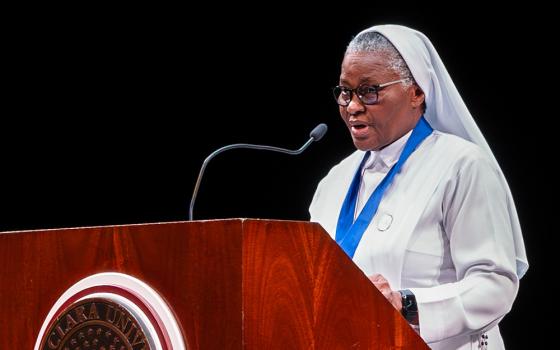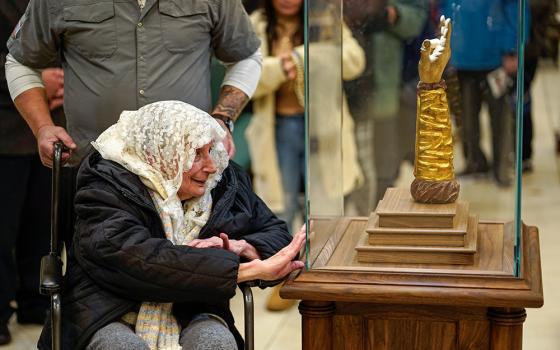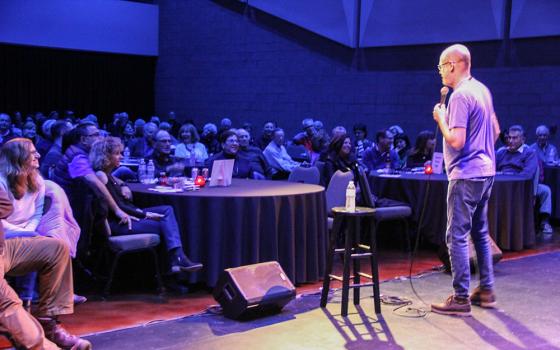
The numbers are familiar and the story has become routine. The number of Catholic schools in the United States and the number of students enrolled in those schools are in decline.
This time of year, especially, as parish councils, school boards and diocesan offices begin planning for the next academic year, the announcements of school closings become almost routine. And no matter where they are closing -- Dubuque, Pittsburgh, Miami or Baltimore -- the reasons cited are nearly uniform: declining populations in older urban areas, dwindling parish membership and tuition increases that put the cost of a Catholic education out of reach of low- and moderate-income families.
Throw into that mix the two years of economic downturn and you have what Jesuit Fr. Joseph O’Keefe calls “a perfect storm” of bad times for Catholic schools.
U.S. Catholic school enrollment reached its peak during the early 1960s when there were more than 5.2 million students in almost 13,000 schools across the nation, according to statistics from the National Catholic Education Association. The 1970s and 1980s saw a steep decline in both the number of schools and students. By 1990, there were approximately 2.5 million students in 8,719 schools.
Hope emerged in the mid-1990s when, although schools kept closing, enrollment across the national network of Catholic schools saw steady, albeit small increases. However, from 2000 until now school closings continued and enrollment declined by 17 percent. The most seriously affected have been elementary schools.
This is tough time to be in Catholic education, said O’Keefe, dean of the Lynch School of Education at Boston College. “Sometimes I get very discouraged.” School closings are sad and heartbreaking, he said. “It’s a dying process and it’s hard.”
He has great empathy for pastors and bishops who often bear the brunt of parents’ anger when a school is closed. Bishops and pastors aren’t heartless, O’Keefe said. “The fact is, they don’t have the resources to [keep all schools open].”
O’Keefe isn’t predicting the end of the Catholic educational system in the United States, but he also says, “It can’t be business as usual. ... It’s a reinvention, a reinventing of the whole system. That’s really what it will take.”
This time of reinvention is also a period of experimentation. Many models of new Catholic schools are being tried.
“The structures of schools that are emerging are very different from the traditional parish structure,” O’Keefe said. He cites as an example a project he is working on with the Boston archdiocese. Three parish schools are being closed in two towns, Lawrence and Quincy, Mass., and next fall, one new school will emerge -- one school that can draw on the resources of three parishes.
That is a trend O’Keefe sees increasing, even in areas where Catholic populations are growing. “They’ll no longer be parish schools, but they’ll be Catholic schools, part of a diocesan system,” he said.
Charter schools
One alternative model emerging is to convert Catholic schools to charter schools. Charter schools are private schools that can use public money to educate students. Under this model, schools would shed their “explicit religious identity” but maintain a “Catholic philosophy.”
Seton Education Partners (www.setonpartners.org) is dedicated to preserving urban Catholic schools, which it describes as “a national treasure.” Among the resources the organization has available is a series of reports called “Catholic Schools Become Charter Schools,” which can guide church leaders and Catholic educators exploring the charter school idea.
One of the most promising “Catholic” charter school experiments was in the Washington archdiocese. A story in The Washington Post earlier this year described it: “In 2008, the archdiocese of Washington gave up control of seven of its financially struggling inner-city schools, stripping down crucifixes and turning the facilities into secular charter schools in three months. Dozens of teachers and hundreds of students departed; 1,000 new students signed up.
“The reincarnated schools walked a fine line between staying secular and capitalizing on Catholic schools’ reputation for quality inner-city education. The schools made clear that God wasn’t part of the picture but focused their curricula on character values and ‘moral virtue.’ And many parents flocked to the schools because they believed their children would receive a free parochial education.”
The future of those schools is uncertain, however, after Congress voted to stop new applications in the D.C. Opportunity Scholarship Program, a federally funded school voucher program for District of Columbia students.
Cristo Rey schools
Cristo Rey is a network of 24 Catholic schools (www.cristoreynetwork.org) that aims to serve urban high school youth with a college prep education. It began as a single Jesuit high school in Chicago in 1996. A cornerstone of the schools is their work-study program. Each student does part-time, entry-level work for a sponsoring business, which pays the student’s wages to the school. Money earned goes to offset the real cost of the student’s education and the student gets early exposure navigating the corporate environment.
O’Keefe said that Boston College psychologists studied the Cristo Rey model and found that its work-study program “not only brings in money but it creates a level of creativity and maturity that really bodes well for long-term success in college and beyond. That is a great model.”
But it is also a limited model, he said. “It can’t be scaled up,” he said, because job placement opportunities are limited. “But it is great for what it does; there is no doubt about that.”
Another stellar performer among successful urban Catholic schools is the NativityMiguel Network for middle schools (www.nativitymiguelschools.org). Founded with Jesuit and Christian Brother inspiration in 2006, the network is comprised of 64 schools serving more than 4,400 students in 27 states. The school’s intensive curriculum incorporates evening and summer programs. It is a highly successful model -- 90 percent of the schools’ alumni graduate from high school -- but not the model for all Catholic middle schools.
According to O’Keefe, the best lesson learned from the Cristo Rey and NativityMiguel schools is not exactly what they do but how they do it. He means the networking: “We would be able to benefit from the experience of the people who came before us even though each particular community has its own culture and identity and what have you. ... It is innovation and creativity and then doing networking around best practices.”
Catholic universities
According to O’Keefe, Catholic universities are also getting mightily involved in preserving the Catholic school tradition and helping Catholic schools move into the future with vigor. He points to a number of examples:
- Last September, Indiana’s University of Notre Dame and Seton Education Partners cosponsored a symposium, “Financing At-Risk Catholic and Faith-based Schools: Exploring Alternatives to School Closure.”
- This September, Boston College and Fordham University in New York will cosponsor a conference on how Catholic universities can effectively work with schools to enhance academic quality.
- Teacher corps programs have steadily grown -- for example, LaSallian Association of New Catholic Educators, or LANCE; Loyola Marymount University’s Partners in Los Angeles Catholic Education, or PLACE Corps; Magis Catholic Teacher Corps at Creighton University in Omaha, Neb.; the Urban Catholic Teachers Corps from Boston College; and Notre Dame’s ACE Service Through Teaching Program. All these programs place recent college graduates as full-time teachers in under-resourced Catholic schools.
- On Easter Monday this year, a group of representatives of Catholic universities will be meeting with the officers of the National Catholic Educational Association to find out how universities and schools can cooperate and collaborate more effectively.
O’Keefe said this kind of cooperation didn’t used to happen. “Catholic higher education institutions are used to competing with each other. So if we could actually find a way to cooperate with one another, that would be very good and more effective.”
Boston College got a major boost in its ability to help Catholic schools. It received March 15 a $20 million gift from Barbara and Patrick Roche to support the college’s Center for Catholic Education, which is part of the Lynch School of Education, where O’Keefe is dean. The donation will be used to train teachers and administrators, and to develop curriculum for Catholic schools, Boston College’s president, Jesuit Fr. William Leahy, said in a media release.
O’Keefe sees all of these things as signs of the reinvention of the Catholic school system. “It is a time of real reinvention, and that takes a lot of partners. It takes various institutions to be engaged. It takes a diocese to make a commitment, and parishes where kids aren’t in Catholic schools to be involved. It takes universities,” he said. “It has to be a new way of doing things. And much of that new way of doing things, again, involves lay leadership.”
For a long time, it has been a ministry for laypeople to teach in Catholic schools, O’Keefe said. “But now it’s really becoming a ministry of laypeople who are actually making the decisions, administering the schools, charting the future direction. Obviously, clergy are involved, but it’s no longer the pastor running the school. That’s rare, and becoming even more rare.
“Which brings both challenges but it also brings some wonderful opportunities. In many ways I think the lay leadership we’ve seen in [Catholic] higher ed and in [Catholic] health care we’re now starting to see at the elementary level. And we see it very much at the high school level too. To me, that’s an encouraging sign.”
[Dennis Coday is an NCR staff writer. His e-mail address is dcoday@ncronline.org.]


